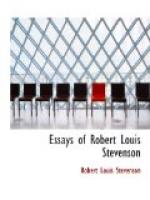NOTES
This article originally appeared in The English Illustrated Magazine for May 1883, Vol. I, pp. 300-305. It was accompanied with illustrations by Randolph Caldecott. The essay was later included in the volume Memories and Portraits (1887).
The astonishing fidelity and devotion of the dog to his master have certainly been in part repaid by men of letters in all times. A valuable essay might be written on the Dog’s Place in Literature; in the poetry of the East, hundreds of years before Christ, the dog’s faithfulness was more than once celebrated. One of the most marvellous passages in Homer’s Odyssey is the recognition of the ragged Ulysses by the noble old dog, who dies of joy. In recent years, since the publication of Dr. John Brown’s Rab and his Friends (1858), the dog has approached an apotheosis. Among innumerable sketches and stories with canine heroes may be mentioned Bret Harte’s extraordinary portrait of Boonder: M. Maeterlinck’s essay on dogs: Richard Harding Davis’s The Bar Sinister: Jack London’s The Call of the Wild: and best of all, Alfred Ollivant’s splendid story Bob, Son of Battle (1898) which has every indication of becoming an English classic. It is a pity that dogs cannot read.
[Note 1: The morals of dog-kind. Stevenson discusses this subject again in his essay Pulvis et Umbra (1888).]
[Note 2: Who whet the knife of the vivisectionist or heat his oven. Stevenson was so sympathetic by nature that once, seeing a man beating a dog, he interfered, crying, “It’s not your dog, it’s God’s dog.” On the subject of vivisection, however his biographer says: “It must be laid to the credit of his reason and the firm balance of his judgment that although vivisection was a subject he could not endure even to have mentioned, yet, with all his imagination and sensibility, he never ranged himself among the opponents of this method of inquiry, provided, of course, it was limited, as in England, with the utmost rigour possible.”—Balfour’s Life, II, 217. The two most powerful opponents of vivisection among Stevenson’s contemporaries were Ruskin and Browning. The former resigned the Professorship of Poetry at Oxford because vivisection was permitted at the University: and the latter in two poems Tray and Arcades Ambo treated the vivisectionists with contempt, implying that they were cowards. In Bernard Shaw’s clever novel Cashel Byron’s Profession, The prize-fighter maintains that his profession is more honorable than that of a man who bakes dogs in an oven. This novel, by the way, which he read in the winter of 1887-88, made an extraordinary impression on Stevenson; he recognised its author’s originality and cleverness immediately, and was filled with curiosity as to what kind of person this Shaw might be. “Tell me more of the inimitable author,” he cried. It is a pity that Stevenson did not live to see the vogue of Shaw as a dramatist, for the latter’s early novels produced practically no impression on the public. See Stevenson’s highly entertaining letter to William Archer, Letters, II, 107.]




